Contribution Factor Analysis of the Wuhan Yangtze River Bridge Deformation Using Sentinel-1A SAR Imagery and In Situ Data
Abstract
:1. Introduction
2. Introduction to the Study Area and the Dataset
2.1. Study Area
2.2. Dataset
3. Method
3.1. SBAS-InSAR Technology
3.2. Data Processing Flow of SBAS InSAR
- 75 Sentinel-1A images were converted into Single Looking Complex (SLC) images.
- Interference pairs generation: The image of 3 April 2021 was selected as reference image, and the threshold of time baseline and spatial baseline were set to 90 days and 45%, then 290 interference pairs were derived.
- Interference and unwrapping processing: After images were registered, interferometric processing is applied to the interferometric pairs to generate interferograms. Subsequently, flat earth effects are mitigated, Goldstein filtering is performed, coherence is computed, and phase unwrapping is executed using the minimum cost flow method. Following these steps, a phase map is generated.
- Refinement and re-flatting: The area in the image that is far from the deformation area and has no residual terrain stripes was selected, and no fewer than 30 Ground Control Points (GCPs) were selected, then orbit refinement polynomials were used for refinement, and re-flatting was performed based on GCPs.
- Linear deformation and elevation coefficient solution: An error correction model for the elevation coefficient and deformation rate of coherent points were established, then SVD was used to solve the model, and the deformation of interference pairs and elevation coefficient were obtained.
- Elimination of atmospheric phase: To eliminate the atmospheric phase and obtain the deformation time series, high-pass filtering in the time domain and low-pass filtering in the spatial domain were employed.
- Geocoding: The processing result in the radar coordinate system (Cartesian coordinate system) was converted to the geographic coordinate system to obtain the final results.
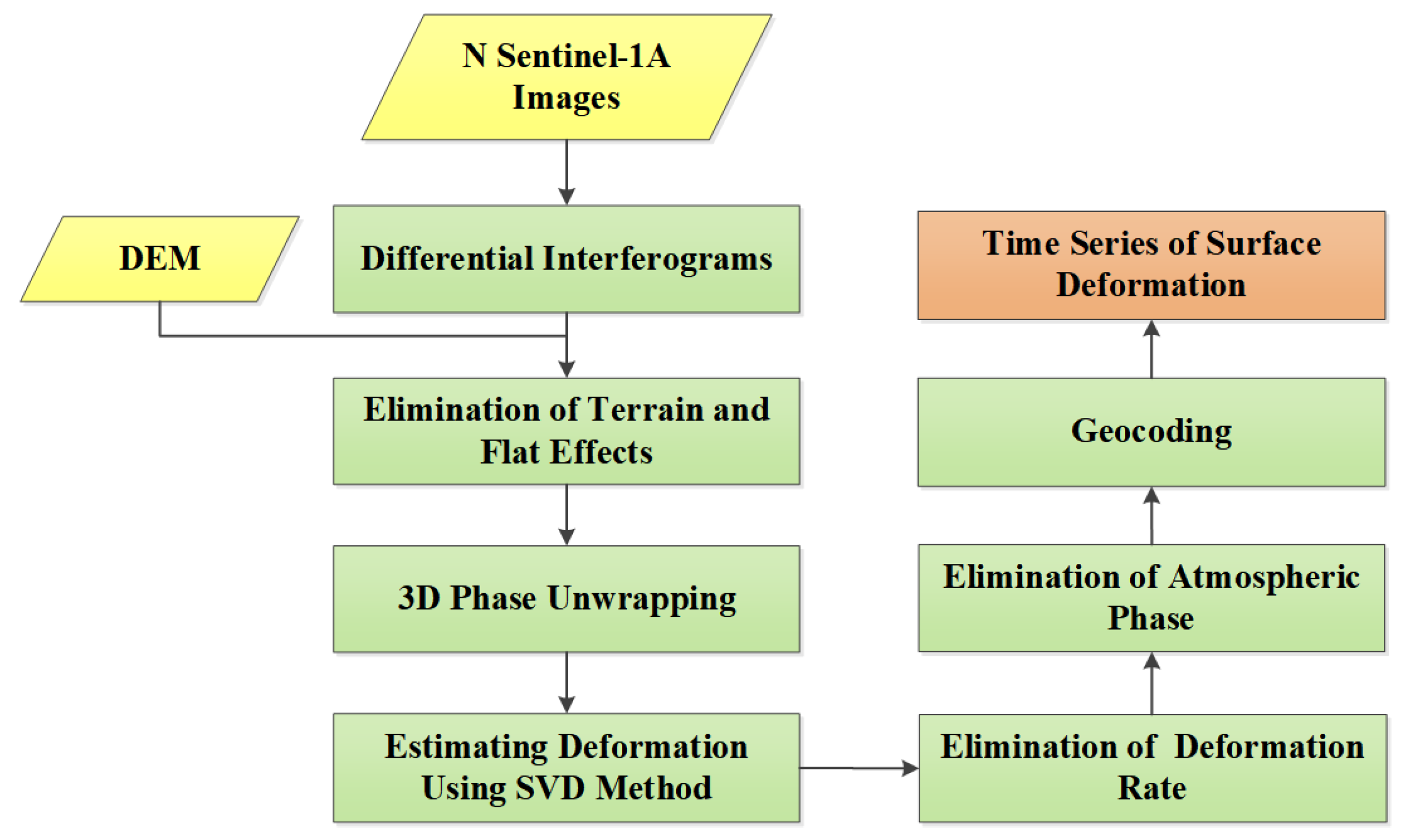
4. SBAS InSAR Results and Precision Validation
4.1. SBAS InSAR Results
4.2. Precision Validation of SBAS Data
5. Discussion
5.1. Relationship between Bridge Structure and Deformation
5.2. Relationship between Human Activity and Deformation
5.3. Relationship between Temperature and Deformation
5.4. Relationship between Stratigraphy under the Bridge and Deformation
6. Conclusions
- The SBAS-InSAR results indicate a vertical deformation rate for the Wuhan Yangtze River Bridge and area around the bridge ranging from −18.2 to 15.4 mm/year. While the vertical deformation rate of the bridge structure remains relatively modest (−15.6 to 10.7 mm/year), during the study period, the maximum uplift and lowering values recorded were 37.3 mm and −38.5 mm, part of the deformation belonging to rebound deformation.
- According to the experimental results, it was found that the lowering and uplifting of the Wuhan Yangtze River Bridge body occurred alternately.
- By analyzing the deformation time series of characteristic points, it can be inferred that the reduction in human activity is the reason for the lower deformation amplitude from January to October 2020 compared to after October 2020.
- After comparing the deformation of characteristic points with the temperature data of meteorological stations located 15.5 km apart from the bridge, a positive correlation was found for only a portion of the bridge.
- By analyzing the deformation rates along the Wuhan Yangtze River Bridge, it was found that there is no significant settlement for piers built on highly compressible soils and no significant deformation for piers built on rock. This implies that the observed deformations are presumably absorbed by the structure. In conclusion, there is no direct correlation between observed sinkings and stratigraphy under the bridge piers.
Author Contributions
Funding
Institutional Review Board Statement
Informed Consent Statement
Data Availability Statement
Acknowledgments
Conflicts of Interest
References
- Guo, M.W.; Dong, X.C.; Yang, Z. Settlement analysis of the giant open caisson during the construction of the Changtai Yangtze River Bridge. Front. Earth Sci. 2023, 10, 1056695. [Google Scholar] [CrossRef]
- Wang, C.; Zhou, L.; Ma, J.; Shi, A.; Li, X.; Liu, L.; Zhang, Z.; Zhang, D. GB-RAR Deformation Information Estimation of High-Speed Railway Bridge in Consideration of the Effects of Colored Noise. Appl. Sci. 2022, 12, 10504. [Google Scholar] [CrossRef]
- Ni, Y.Q.; Wang, Y.W.; Zhang, C. A Bayesian approach for condition assessment and damage alarm of bridge expansion joints using long-term structural health monitoring data. Eng. Struct. 2020, 212, 110520. [Google Scholar] [CrossRef]
- Zhu, S.; Levinson, D.; Liu, H.; Harder, K. The traffic and behavioral effects of the I-35W Mississippi River bridge collapse. Transp. Res. Part A Policy Pract. 2010, 10, 771–784. [Google Scholar] [CrossRef]
- Milillo, P.; Giardina, G.; Perissin, D.; Milillo, G.; Coletta, A.; Terranova, C. Pre-Collapse Space Geodetic Observations of Critical Infrastructure: The Morandi Bridge, Genoa, Italy. Remote Sens. 2019, 12, 1403. [Google Scholar] [CrossRef]
- Long, S.; Liu, W.; Ma, J.; Tong, A.; Wu, W.; Zhu, C. Health monitoring and safety evaluation of bridge dynamic load with a ground-based real aperture radar. Surv. Rev. 2021, 91, 172–186. [Google Scholar] [CrossRef]
- Beshr, E.W. Structural deformation monitoring and analysis of highway bridge using accurate geodetic techniques. Engineering 2015, 8, 488–498. [Google Scholar] [CrossRef]
- Cusson, D.; Trischuk, K.; Hébert, D.; Hewus, G.; Gara, M.; Ghuman, P. Satellite-Based InSAR Monitoring of Highway Bridges: Validation Case Study on the North Channel Bridge in Ontario, Canada. Transp. Res. Rec. 2018, 2672, 76–86. [Google Scholar] [CrossRef]
- Yi, T.H.; Li, H.N.; Gu, M. Recent research and applications of GPS based technology for bridge health monitoring. Sci. China Technol. Sci. 2010, 10, 2597–2610. [Google Scholar] [CrossRef]
- Beshr, E.W.; Kaloop, M.R. Monitoring bridge deformation using auto-correlation adjustment technique for total station observations. Positioning 2013, 4, 28338. [Google Scholar] [CrossRef]
- Liu, X.; Wang, P.; Lu, Z.; Gao, K.; Wang, H.; Jiao, C.; Zhang, X. Damage Detection and Analysis of Urban Bridges Using Terrestrial Laser Scanning (TLS), Ground-Based Microwave Interferometry, and Permanent Scatterer Interferometry Synthetic Aperture Radar (PS-InSAR). Remote Sens. 2019, 11, 580. [Google Scholar] [CrossRef]
- Ferretti, A.; Prati, C.; Rocca, F. Permanent scatterers in SAR interferometry. IEEE Trans. Geosci. Remote Sens. 2001, 1, 8–20. [Google Scholar] [CrossRef]
- Hanssen, R.F. Satellite radar interferometry for deformation monitoring: A priori assessment of feasibility and accuracy. Int. J. Appl. Earth Obs. Geoinf. 2005, 6, 3–4. [Google Scholar] [CrossRef]
- Di Martino, G.; Esposito, M.; Festa, B.; Lodice, A.; Mancini, L.; Poreh, D.; Riccio, D.; Ruello, G. Railway Bridge Monitoring with Sar: A Case Study. In Proceedings of the IEEE IGARSS2018—2018IEEE International Geoscience and Remote Sensing Symposium, Valencia, Spain, 22 July 2018. [Google Scholar]
- Huang, Q.H.; Xie, X.Y.; Fan, H.T. Interferometric Deformation Monitoring Method and Application of Spaceborne/Ground-Based Radar, 1st ed.; Science Press: Beijing, China, 2014; pp. 1–5. [Google Scholar]
- Castellazzi, P.; Garfias, J.; Martel, R.; Brouerd, C.; Rivera, A. InSAR to support sustainable urbanization over compacting aquifers: The case of Toluca Valley, Mexico. Int. J. Appl. Earth Obs. Geoinf. 2017, 63, 33–44. [Google Scholar] [CrossRef]
- Huang, Q.H.; Crosetto, M.; Monserrat, O.; Crippa, B. Displacement monitoring and modelling of a high-speed railway bridge using C-band Sentinel-1 data. ISPRS-J. Photogramm. Remote Sens. 2017, 128, 204–211. [Google Scholar] [CrossRef]
- Zhang, L.; Sun, Q.; Hu, J. Potential of TCPInSAR in Monitoring Linear Infrastructure with a Small Dataset of SAR Images: Application of the Donghai Bridge, China. Appl. Sci. 2018, 8, 425. [Google Scholar] [CrossRef]
- Zhao, J.; Wu, J.; Ding, X.; Wang, M. Elevation Extraction and Deformation Monitoring by Multitemporal InSAR of Lupu Bridge in Shanghai. Remote Sens. 2017, 9, 897. [Google Scholar] [CrossRef]
- Berardino, P.; Fornaro, G.; Lanari, R.; Sansosti, E. A new algorithm for surface deformation monitoring based on small baseline differential SAR interferograms. IEEE Trans. Geosci. Remote Sens. 2002, 11, 2375–2383. [Google Scholar] [CrossRef]
- Ma, J. BDS/GPS deformation analysis of a long-span cable-stayed bridge based on colored noise filtering. Geod. Geodyn. 2023, 14, 163–171. [Google Scholar] [CrossRef]
- Zhao, Y.Z.; Zhou, L.; Wang, C.; Li, J.H.; Qin, J.; Sheng, H.Q.; Huang, L.K.; Li, X. Analysis of the Spatial and Temporal Evolution of Land Subsidence in Wuhan, China from 2017 to 2021. Remote Sens. 2022, 14, 3142. [Google Scholar] [CrossRef]
- Xu, Y.; Li, T.; Tang, X.; Zhang, X.; Fan, H.; Wang, Y. Research on the Applicability of DInSAR, Stacking-InSAR and SBAS-InSAR for Mining Region Subsidence Detection in the Datong Coalfield. Remote Sens. 2022, 14, 3314. [Google Scholar] [CrossRef]
- Zhou, L.; Guo, J.; Hu, J.; Li, J.; Xu, Y.; Pan, Y.; Shi, M. Wuhan Surface Subsidence Analysis in 2015–2016 Based on Sentinel-1A Data by SBAS-InSAR. Remote Sens. 2017, 9, 982. [Google Scholar] [CrossRef]
- Hooper, A.; Segall, P.; Zebker, H. Persistent scatterer interferometric synthetic aperture radar for crustal deformation analysis, with application to Volcán Alcedo, Galápagos. J. Geophys. Res. Solid Earth 2007, 112, 1–21. [Google Scholar] [CrossRef]
- Du, Y.L.; Su, M.B.; Liu, Y.H.; Wang, Q.M. Study on the Long-term Health Monitoring and Safety Evaluation System for the Wuhan Yangtze River Bridge. J. China Railw. Soc. 2015, 3, 101–110. [Google Scholar]
- Housner, G.W.; Bergman, L.A.; Caughey, T.K.; Housner, G.W.; Bergman, L.A.; Caughey, T.K.; Chassiakos, A.G.; Claus, R.O.; Masri, S.F.; Skelton, R.E.; et al. Structure Control: Past, Present and Future. J. Eng. Mech. 1997, 123, 897–971. [Google Scholar] [CrossRef]
- Tu, Q. Probability Statistics Is Applied to Meteorology; Meteorological Press: Beijing, China, 1984; pp. 222–229. [Google Scholar]
- Wuhan Geotechnical Engineering and Surveying Co. Ltd. Wuhan Engineering Geology, 1st ed.; Huazhong University of Science & Technology Press: Wuhan, China, 2018; pp. 76–77. [Google Scholar]
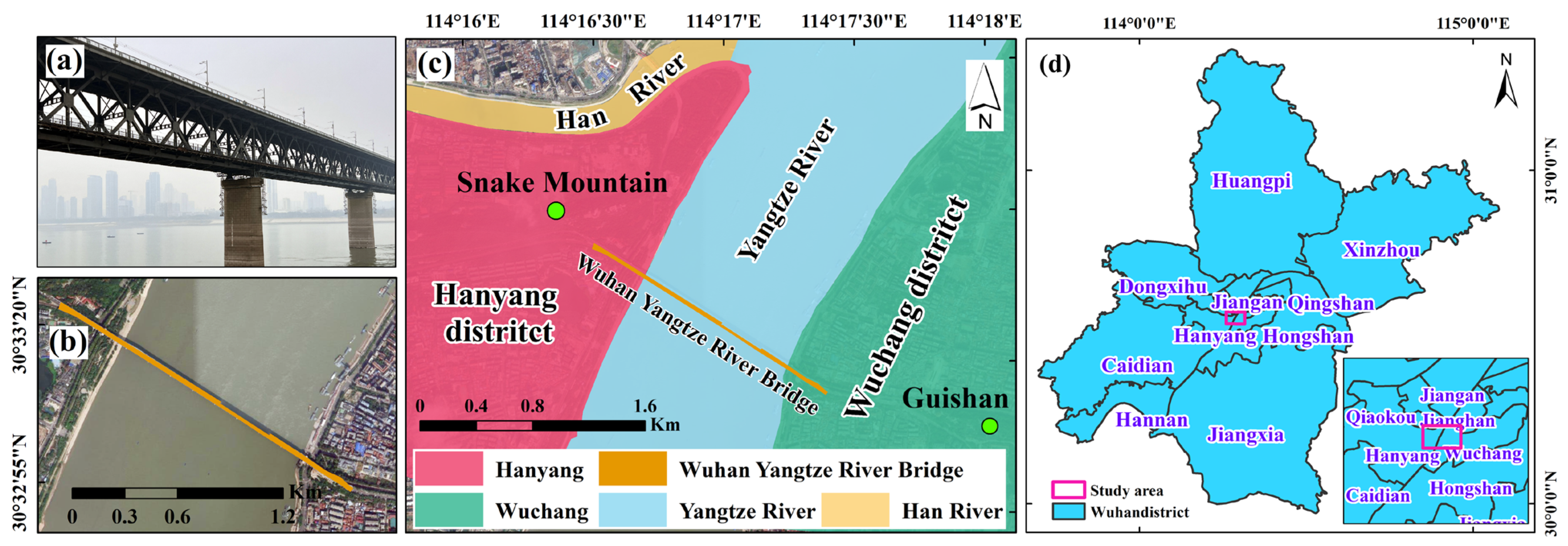

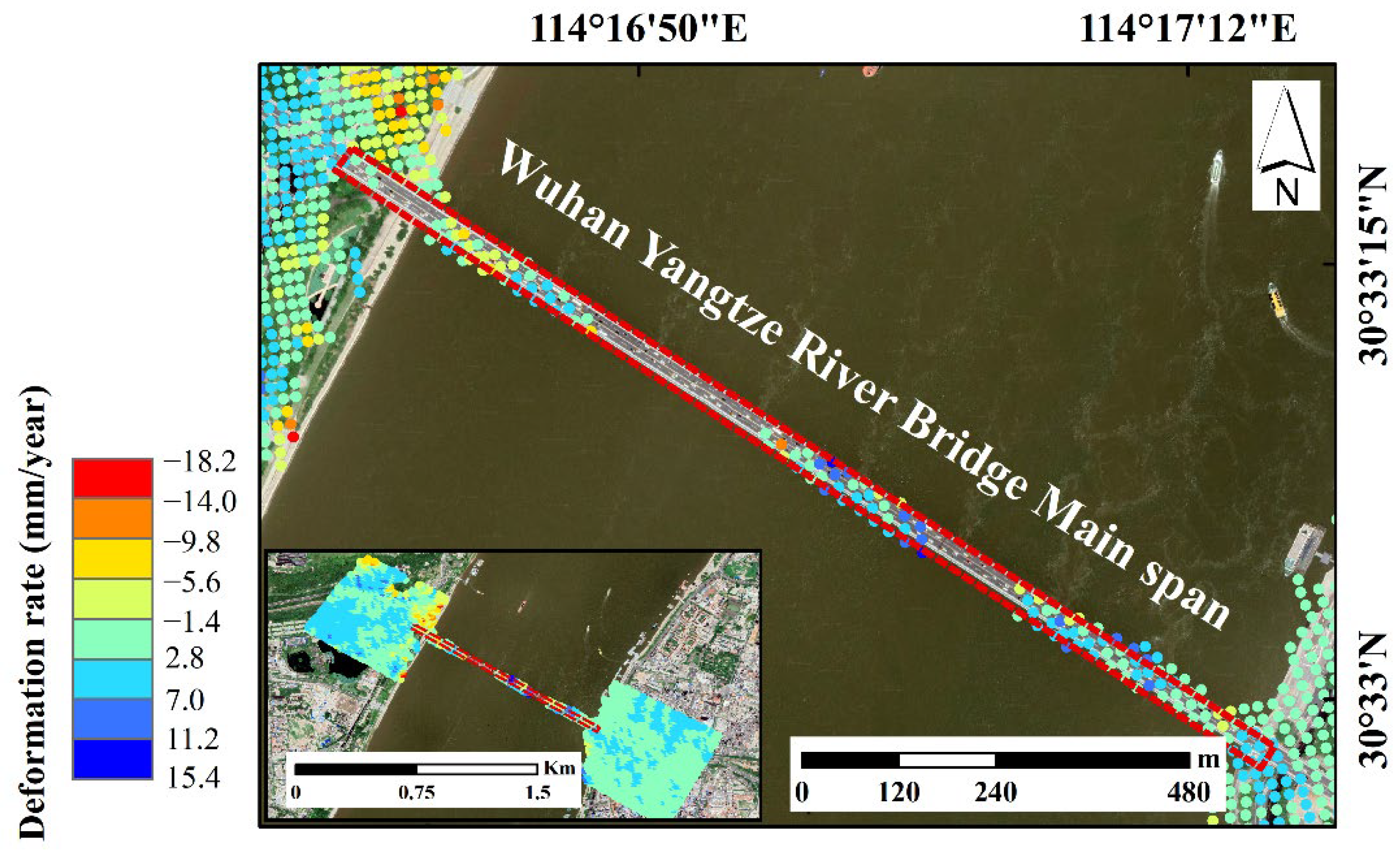
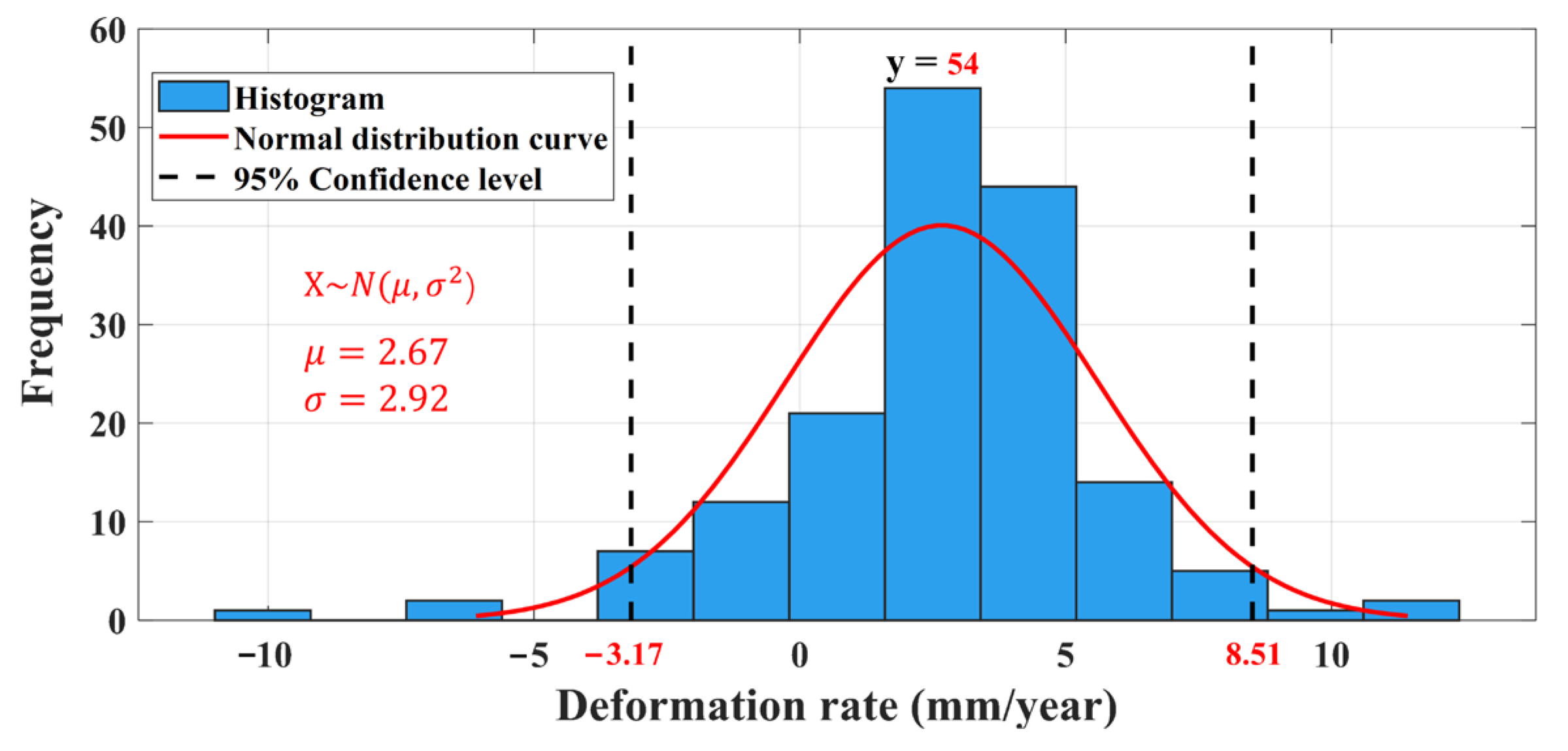
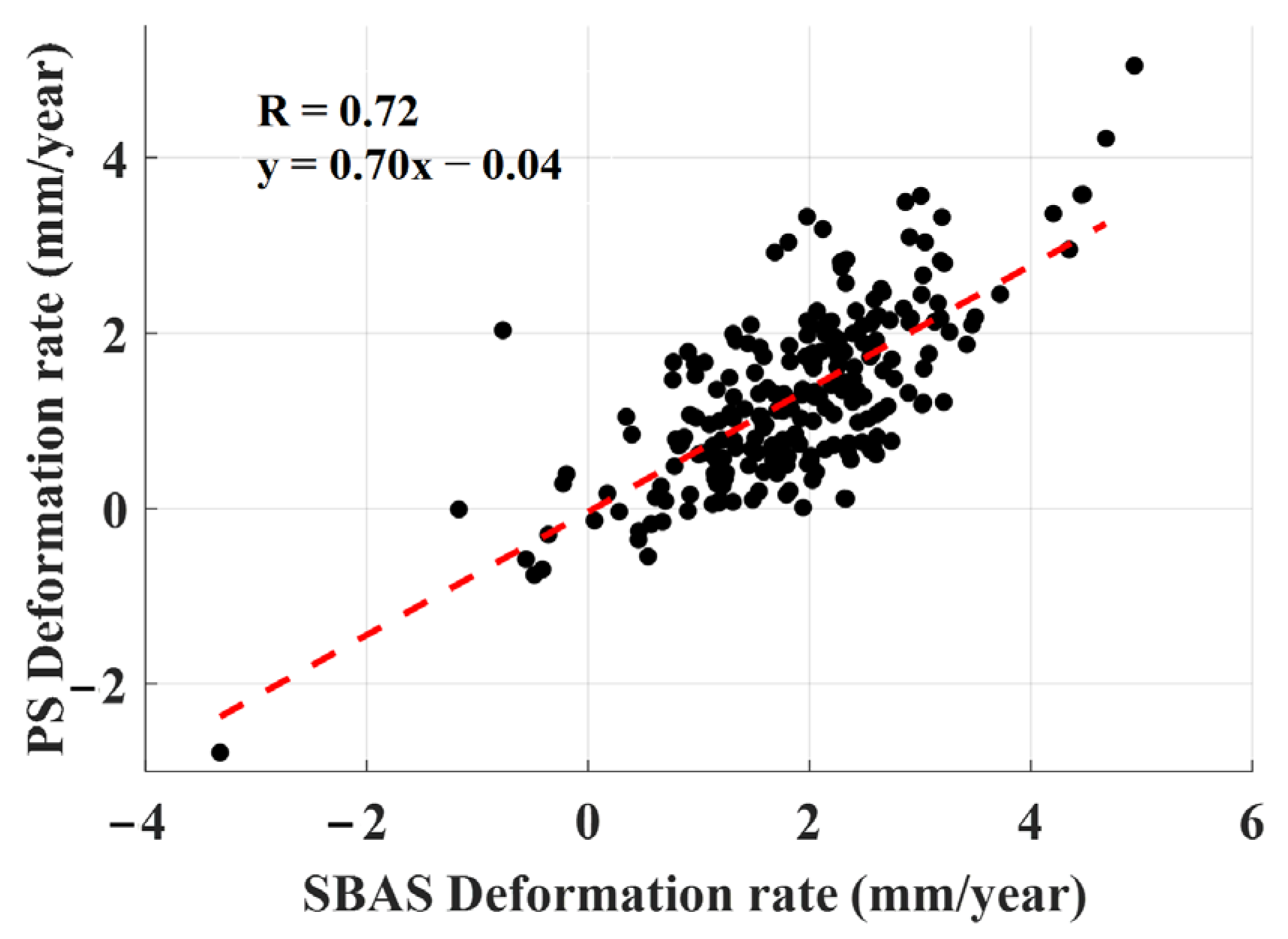

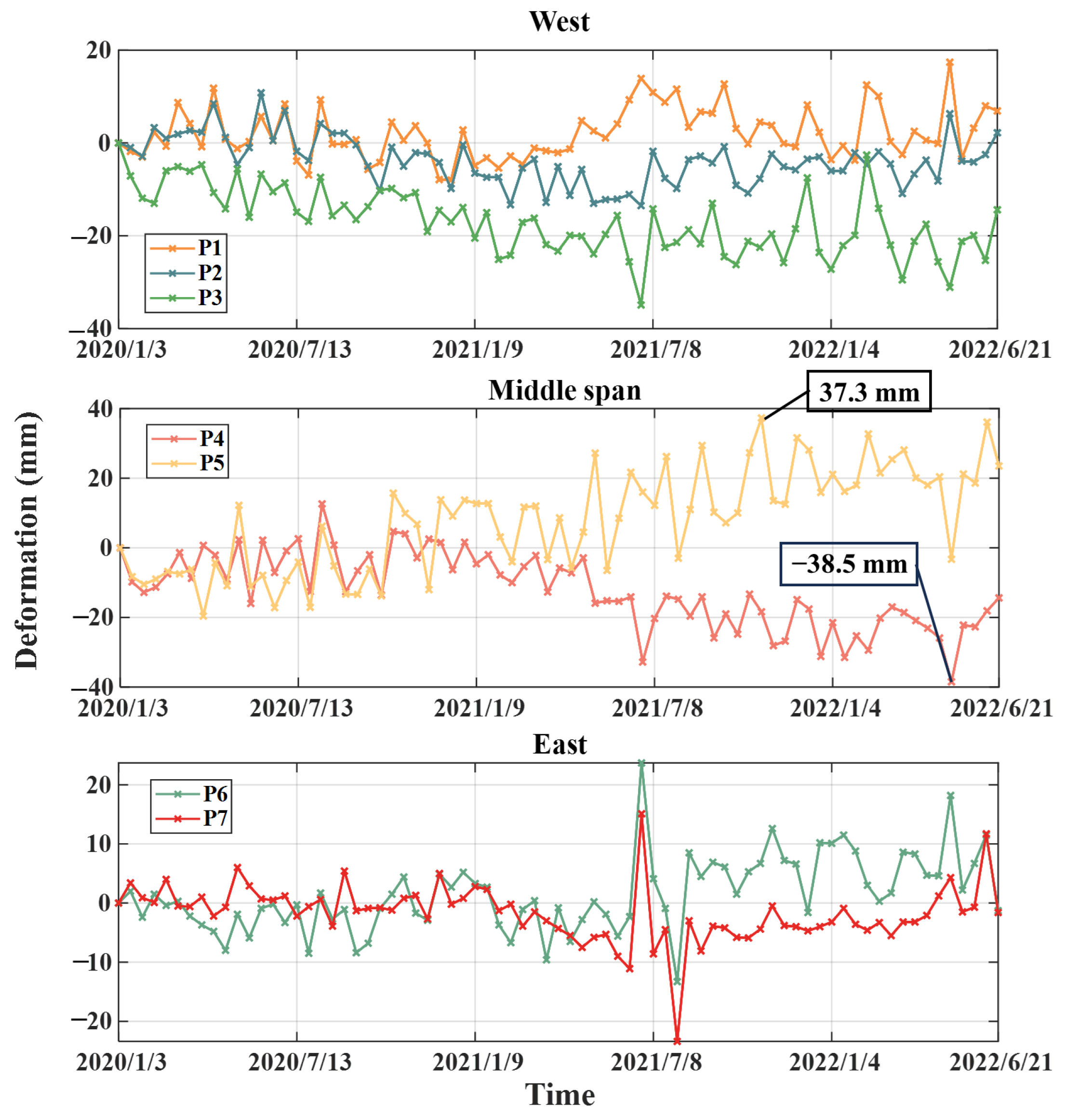

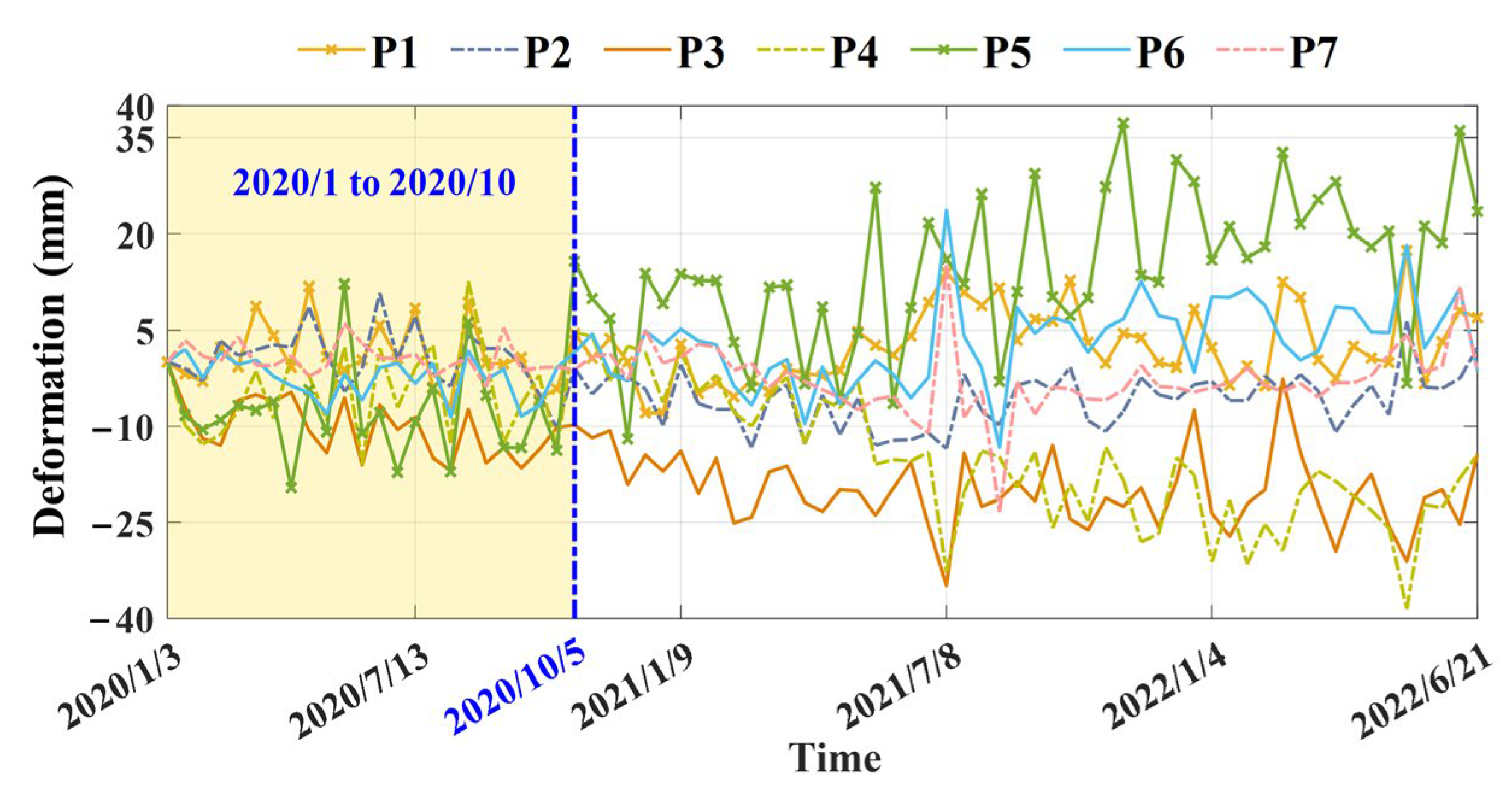
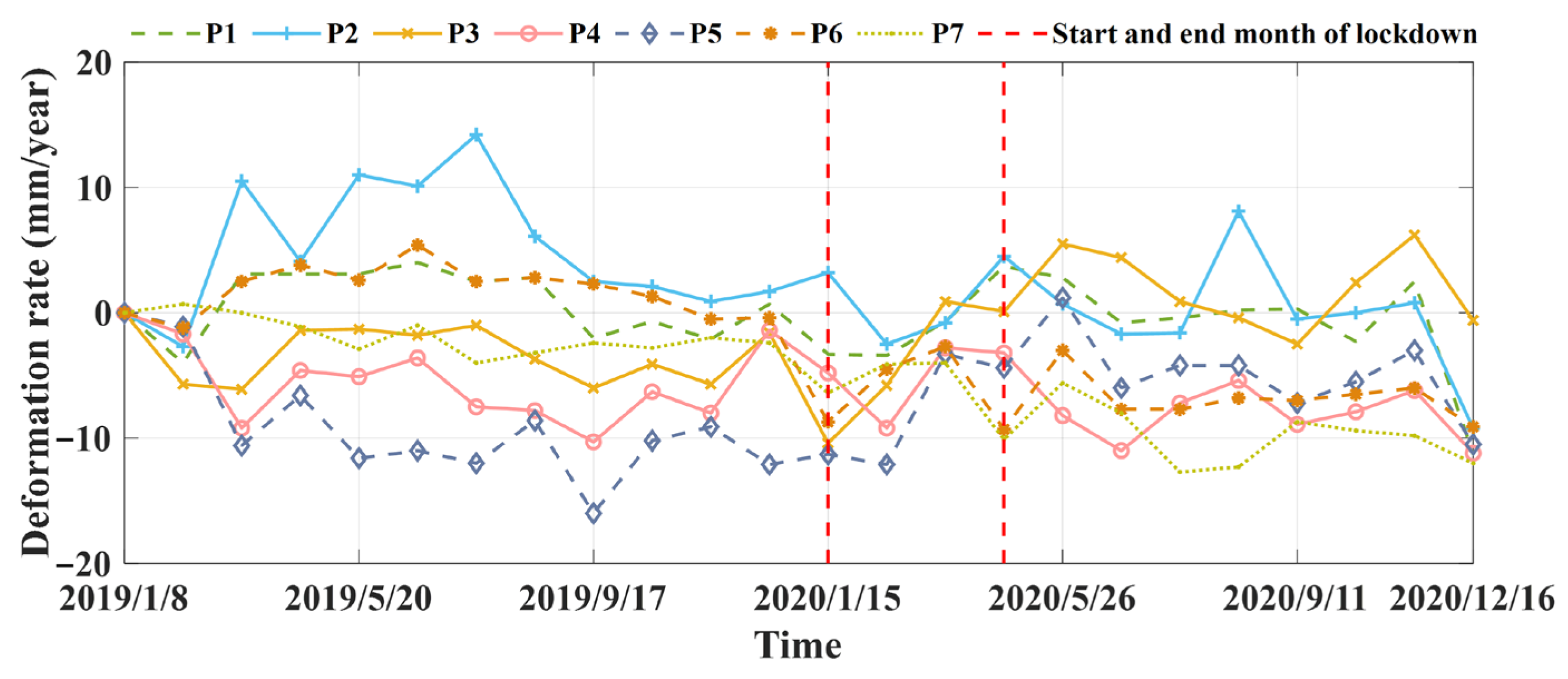
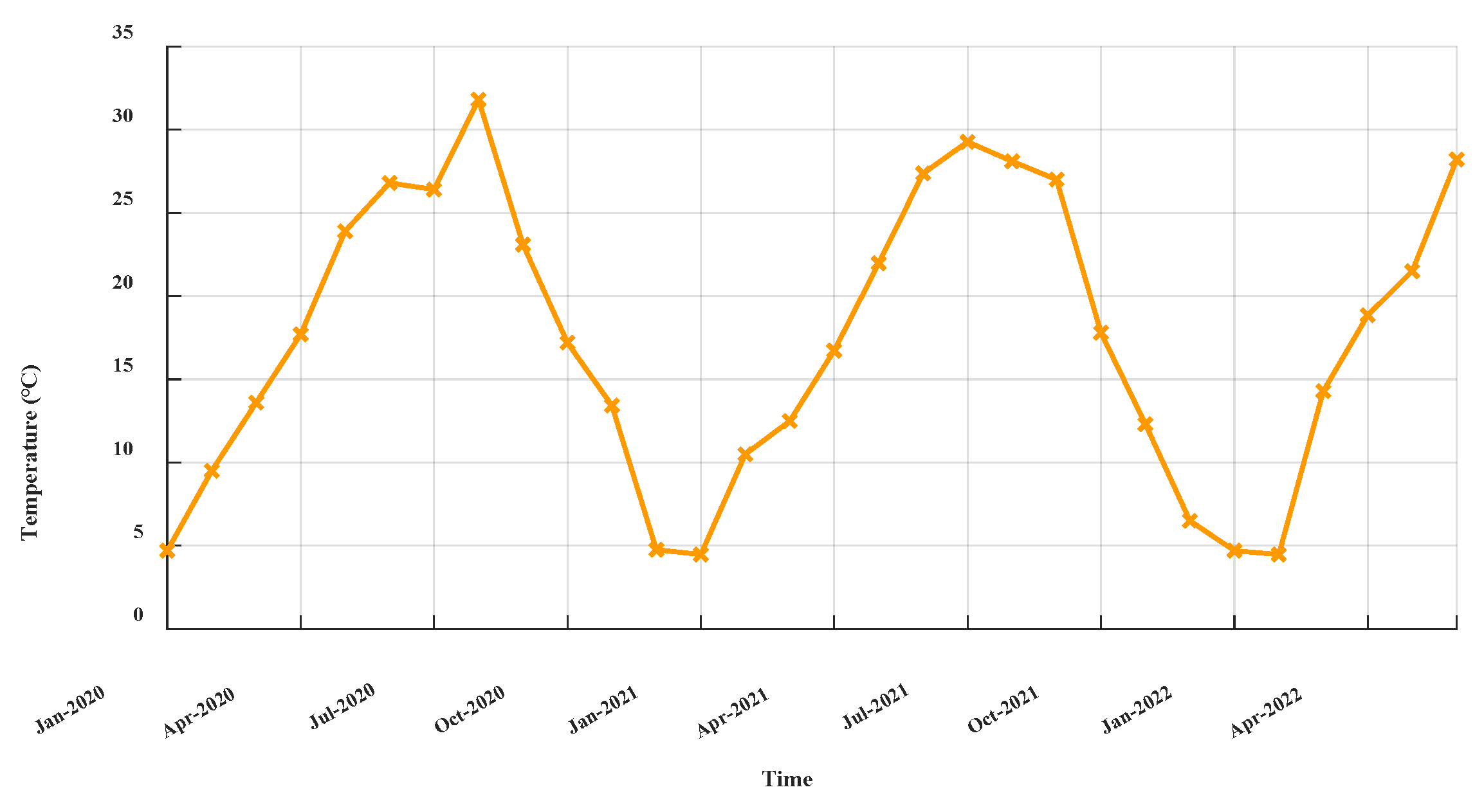

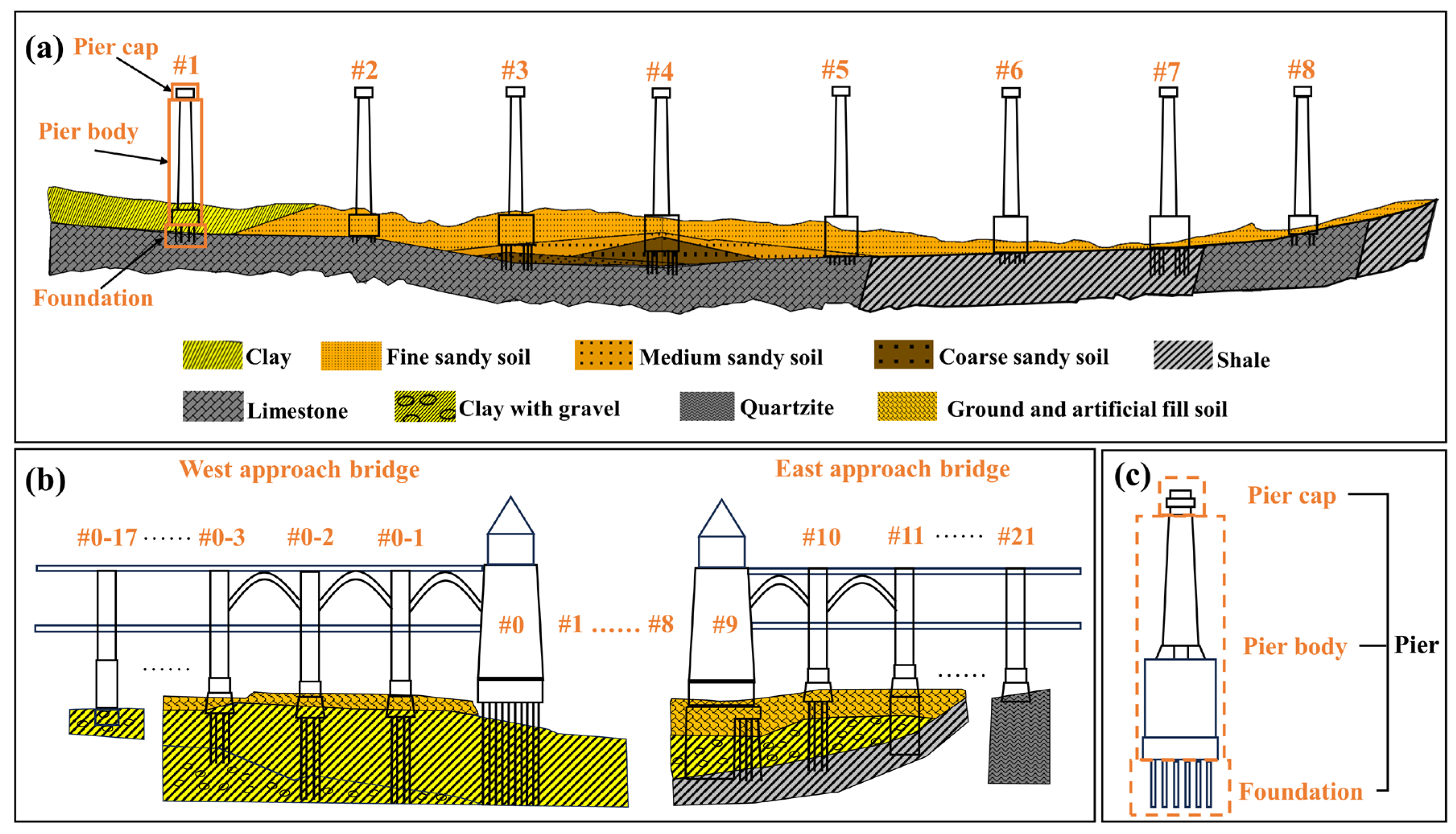
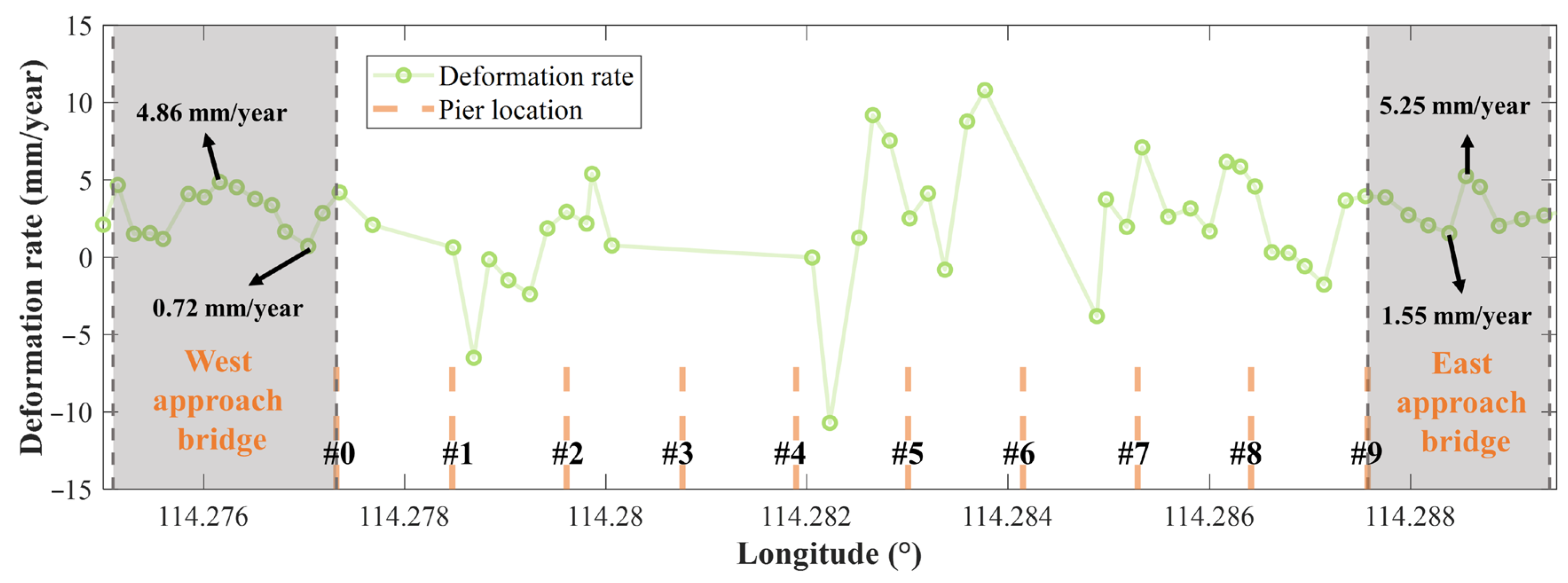
| Satellite Model | Sentinel-1A |
|---|---|
| Orbit direction | Ascending orbit |
| Angle of incidence | 39.7° |
| Band | C |
| Polarization mode | VV |
| Amount | 75 |
| Time span | 3 January 2020~21 June 2022 |
| Point Number | Latitude (Degree) | Longitude (Degree) | Mean Deformation Rate (mm/Year) | Location |
|---|---|---|---|---|
| P1 | 114.27839 | 30.55468 | 1.9 | Near No. 1 pier |
| P2 | 114.27903 | 30.55440 | −1.5 | Between No. 1 pier and No. 2 pier |
| P3 | 114.28010 | 30.55367 | −6.3 | Between No. 2 pier and No. 3 pier |
| P4 | 114.28223 | 30.55258 | −10.7 | Near No. 4 pier |
| P5 | 114.28279 | 30.55241 | 15.4 | Between No. 4 pier and No. 5 pier |
| P6 | 114.28645 | 30.55029 | 4.6 | Near No. 8 pier |
| P7 | 114.28714 | 30.54988 | −1.8 | Between No. 8 pier and the eastern bridgehead |
| Point Number | P1 | P2 | P3 | P4 | P5 | P6 | P7 |
|---|---|---|---|---|---|---|---|
| Correlation | 0.42 | 0.12 | −0.05 | −0.02 | −0.18 | −0.20 | −0.13 |
Disclaimer/Publisher’s Note: The statements, opinions and data contained in all publications are solely those of the individual author(s) and contributor(s) and not of MDPI and/or the editor(s). MDPI and/or the editor(s) disclaim responsibility for any injury to people or property resulting from any ideas, methods, instructions or products referred to in the content. |
© 2023 by the authors. Licensee MDPI, Basel, Switzerland. This article is an open access article distributed under the terms and conditions of the Creative Commons Attribution (CC BY) license (https://creativecommons.org/licenses/by/4.0/).
Share and Cite
Wang, C.; Li, X.; Zhou, L.; Qin, J.; Ma, J.; Luo, Z.; Liu, L. Contribution Factor Analysis of the Wuhan Yangtze River Bridge Deformation Using Sentinel-1A SAR Imagery and In Situ Data. Appl. Sci. 2023, 13, 11955. https://doi.org/10.3390/app132111955
Wang C, Li X, Zhou L, Qin J, Ma J, Luo Z, Liu L. Contribution Factor Analysis of the Wuhan Yangtze River Bridge Deformation Using Sentinel-1A SAR Imagery and In Situ Data. Applied Sciences. 2023; 13(21):11955. https://doi.org/10.3390/app132111955
Chicago/Turabian StyleWang, Cheng, Xinyi Li, Lv Zhou, Jie Qin, Jun Ma, Ziyan Luo, and Lilong Liu. 2023. "Contribution Factor Analysis of the Wuhan Yangtze River Bridge Deformation Using Sentinel-1A SAR Imagery and In Situ Data" Applied Sciences 13, no. 21: 11955. https://doi.org/10.3390/app132111955
APA StyleWang, C., Li, X., Zhou, L., Qin, J., Ma, J., Luo, Z., & Liu, L. (2023). Contribution Factor Analysis of the Wuhan Yangtze River Bridge Deformation Using Sentinel-1A SAR Imagery and In Situ Data. Applied Sciences, 13(21), 11955. https://doi.org/10.3390/app132111955





